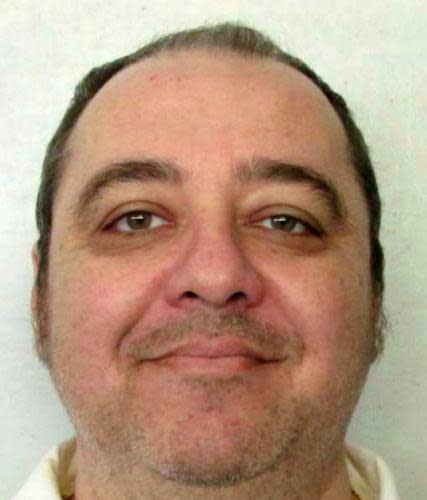‘Astonishingly cruel’: Alabama seeks to test execution method on death row ‘guinea pig’

Kenneth Smith is one of two living Americans who can describe what it is like to survive an execution, having endured an aborted lethal injection last November during which he was subjected to excruciating pain tantamount, his lawyers claim, to torture.
Related: Ex-Alabama deputy sheriff sentenced to prison for sexual assault on woman in his custody
Nine months later Smith has been singled out for another undesirable distinction. If the state of Alabama has its way, he will become the test dummy for an execution method that has never before been used in judicial killings and which veterinarians consider unacceptable as a form of euthanasia for animals – death by nitrogen gas.
Alabama has announced its intention to become the first state in the nation to kill a prisoner by forcing him to breathe pure nitrogen. The attorney general has asked the state supreme court to set a fresh execution date for Smith using the untested system.
The method, known as “nitrogen hypoxia”, theoretically works by replacing the oxygen breathed by the prisoner with nitrogen. In minutes that would reduce oxygen levels in the individual’s brain and other vital organs to fatally low levels, leading to death by suffocation.
Death penalty experts have decried what is in effect a human experiment. The choice of Smith as the first candidate for the technique, less than a year after he experienced a failed execution, has also been criticized as a double violation of the eighth amendment protection against “cruel and unusual punishments”.
Smith, 58, was convicted of the 1988 murder of Elizabeth Sennett. He was paid $1,000 to kill her by Sennett’s husband, a pastor who was in debt and wanted the insurance payout.

At his trial, the jury voted 11-1 to give Smith a life sentence, but the judge overruled them and sent him to death row.
In 2022, Smith was one of three Alabama death row inmates who suffered catastrophic lethal injection procedures. Officials spent hours unsuccessfully trying to set an intravenous line through which to pump the drugs into him.
Earlier that year, the state took more than three hours to kill Joe Nathan James and later abandoned the execution of Alan Miller after also failing to find a vein. An inquiry was held into the string of disasters, but resulted in no meaningful changes.
Maya Foa, a joint executive director of Reprieve, the human rights group, said that Alabama was doubling down on a policy of human experimentation.
“Alabama has tortured Kenneth Smith once already, strapping him down and stabbing him with needles for more than an hour in a failed attempt to kill him. It is astonishingly reckless and cruel to try again using an untested execution method that has every chance of causing terrible suffering,” Foa said.
Foa added that Alabama’s new published protocol for death-by-nitrogen was “alarmingly vague – officials evidently don’t know what they are doing and are hoping for the best. The state is treating a human being like a guinea pig in a laboratory and calling it justice.”
The state is treating a human being like a guinea pig in a laboratory and calling it justice
Maya Foa
The protocol includes a brief passage on nitrogen hypoxia that has large sections hidden from public view. “This is a vague, sloppy, dangerous and unjustifiably deficient protocol made all the more incomprehensible by heavy redaction in the most important places,” said Deborah Denno, a law professor at the Fordham University law school who has done pioneering research on execution methods.
The protocol, the first that a state has released publicly for nitrogen, indicates that the gas will be pumped into Smith through a “mask assembly”, which will be connected to “breathing gas tubing”. “The mask will be placed and adjusted on the condemned inmate’s face”, it says, and then after the prisoner has been allowed to make a final statement “the Warden will activate the nitrogen hypoxia system”.
The gas will be passed through the mask into the prisoner for 15 minutes, or for five minutes beyond the moment that he flatlines, whichever is longer, the protocol says.
The details given are so vague, Denno said, that it leaves experts to “only speculate about how a state might conduct a nitrogen hypoxia execution”. She added that the placement of a mask on a prisoner’s face “is especially puzzling – what if the inmate tries to take it off, immediately or during the procedure?”
Joel Zivot, a professor of anesthesiology and an expert in lethal injections at Emory University, said that even the term “nitrogen hypoxia” was a misnomer. “Hypoxia means low in oxygen, so someone has combined that with nitrogen and called it a thing. Medically, it’s not a thing – there is no such thing as nitrogen hypoxia. It’s a made-up term,” Zivot said.
Zivot believes the phrase is being used to normalize an untried killing method. “It creates a false sense that it is medically endorsed, which it is not. There has never been any research into nitrogen executions – obviously, any such research would be unethical,” he said.
There is no such thing as nitrogen hypoxia. It’s a made-up term. It creates a false sense that it is medically endorsed, which it is not
Joel Zivot
The reality, Zivot suggested, was that Alabama had no idea whether nitrogen could be used to kill Smith without him suffering a cruel and unusual punishment banned under the US constitution. “They have no clear understanding of what they’re supposed to be doing, and yet they are satisfied with scant anecdotal pieces of information for the highest, most serious form of punishment,” he said.
Nitrogen has been approved as an execution method by three states: Alabama, Mississippi and Oklahoma. Its use as an alternative to lethal injections emerged in 2015 in Oklahoma.
Like many death penalty states, Oklahoma was looking for an alternative to lethal injection, having struggled to procure the necessary drugs as a result of an international boycott by pharmaceutical companies. By contrast, nitrogen is easily obtained as it is naturally abundant, making up 78% of the volume of air.
A team of academics from East Central University in Ada, Oklahoma, was commissioned to look into the option of nitrogen hypoxia, the Marshall Project has reported. It was led by Michael Copeland, a criminal justice professor.
Copeland’s previous experience was as a prosecutor on the western Pacific Ocean islands of Palau, one of the smallest countries in the world. He also worked in the anti-fraud unit of the Oklahoma insurance department.
Copeland had no medical training, and no doctors were involved in advancing the idea of nitrogen as an execution method. His 14-page report was presented to Oklahoma lawmakers, and the method was adopted as part of the state’s death penalty protocol; it went on to be emulated by Alabama.
By contrast, euthanasia guidelines produced by the American Veterinary Medical Association (AVMA), which represents 100,000 veterinarians in the US, reject nitrogen hypoxia for almost all mammals. The gas creates an environment devoid of oxygen that is “distressing for some species”, it says.

 Yahoo News
Yahoo News 
